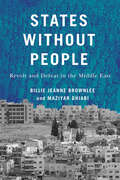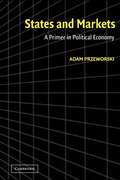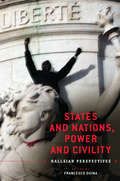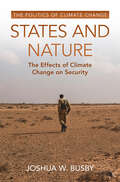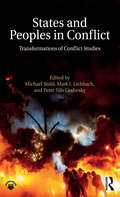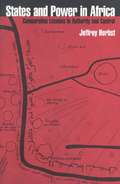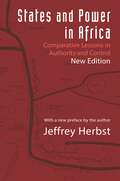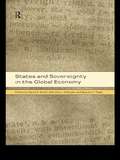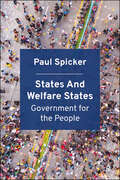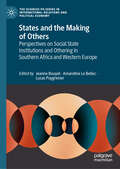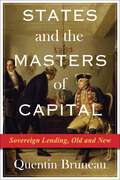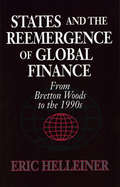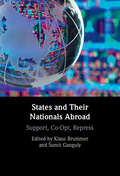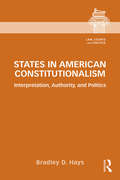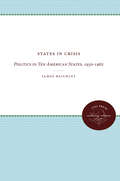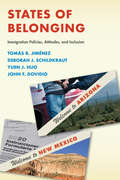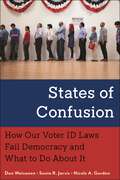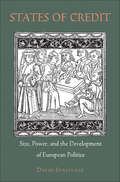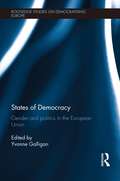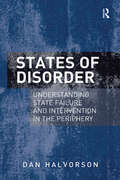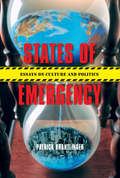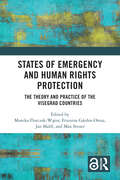- Table View
- List View
States Without People: Revolt and Defeat in the Middle East (McGill-Queen's Studies in Protest, Power, and Resistance)
by Maziyar Ghiabi Billie Jeanne BrownleeThe horizon of emancipatory politics is in ruins, scarred by defeats and ongoing conflicts. Under the auspices of technocapitalist elites and their political allies, a reactionary turn tightens its grip on the world. Civil wars and regional conflicts are surging. The Middle East has become the regional laboratory for a global reconfiguration of power.States Without People explores how revolts that preceded the outbreak of war have fostered a right-wing political culture. In a nuanced discussion of the defeat of popular revolts and the rise of mythological politics, hypermilitarism, and ethnosupremacism, Billie Jeanne Brownlee and Maziyar Ghiabi take readers into the phenomenological depths of citizen politics in Israel, Lebanon, Syria, Iraq, Iran, and Egypt, across the Arabian Peninsula, and beyond. The book highlights three pivotal moments: the outbreak and defeat of popular revolts, the ensuing civil wars, and the complex displacement that has forced millions from their homes.States Without People advances a paradigm shift in state–citizen relations from the vantage point of the Middle East. In the state without people, there is no ideological space for a heterogeneous or self-contradictory citizenry – only for partisans, whose interests overlap with the state’s, and for enemies.
States and Markets: A Primer in Political Economy
by Adam PrzeworskiPolitical economy is the study of decentralized and centralized mechanisms for allocating resources and distributing incomes: markets and states. Both markets and states can be organized and combined in a variety of ways and they jointly determine what the economy produces as well as who gets what. The purpose of this book is to introduce the reader to the concepts and tools for studying relations between states and markets. The focus is methodological. Both the economy and the state are analyzed as networks of relations between principals and agents, occupying particular places in the institutional structure. Having introduced the principal-agent framework, the book analyzes systematically the effect of the organization of the state on the functioning of the economy. The central question is under what conditions government will do what they should be doing and not do what they should not.
States and Nations, Power and Civility: Hallsian Perspectives
by Francesco DuinaCivility in national and international politics is under siege. In this volume, twelve distinguished sociologists and historians from North America, Europe, and China reflect on the nature and preservation of civility in and between nation states and empires in a set of geographically and historically wide-ranging chapters. Civility protects individual self-determination and expression, promotes productive economic activity and wealth, and is central to political stability and peace within and across political communities. Yet power, always concentrated and endemic in nation states and imperial settings, poses great risks to civility. Guided by the perspective of John A. Hall, who has done more to identify and investigate the intricate relationships between states, nations, the power they hold, and civility than any other contemporary social scientist, States and Nations, Power and Civility offers a set of crisp, in-depth investigations regarding the specific mechanisms of civility and how it may be protected.
States and Nature: The Effects of Climate Change on Security
by Joshua BusbyUnder what circumstances might climate change lead to negative security outcomes? Over the past fifteen years, a rapidly growing applied field and research community on climate security has emerged. While much progress has been made, we still don't have a clear understanding of why climate change might lead to violent conflict or humanitarian emergencies in some places and not others. Busby develops a novel argument – based on the combination of state capacity, political exclusion, and international assistance – to explain why climate leads to especially bad security outcomes in some places but not others. This argument is then demonstrated through application to case studies from sub-Saharan Africa, the Middle East, and South Asia. This book will provide an informative resource for students and scholars of international relations and environmental studies, especially those working on security, conflict and climate change, on the emergent practice and study of this topic, and identifies where policy and research should be headed.
States and Peoples in Conflict: Transformations of Conflict Studies
by Mark I. Lichbach Michael Stohl Peter Nils GraboskyThis volume evaluates the state of the art in conflict studies. Original chapters by leading scholars survey theoretical and empirical research on the origins, processes, patterns, and consequences of most forms and contexts of political conflict, protest, repression, and rebellion. Contributors examine key pillars of conflict studies, including civil war, religious conflict, ethnic conflict, transnational conflict, terrorism, revolution, genocide, climate change, and several investigations into the role of the state. The research questions guiding the text include inquiries into the interactions between the rulers and the ruled, authorities and challengers, cooperation and conflict, accommodation and resistance, and the changing context of conflict from the local to the global.
States and Power in Africa: Comparative Lessons in Authority and Control
by Jeffrey HerbstTheories of international relations, assumed to be universally applicable, have failed to explain the creation of states in Africa. There, the interaction of power and space is dramatically different from what occurred in Europe. In his groundbreaking book, Jeffrey Herbst places the African state-building process in a truly comparative perspective, examining the problem of state consolidation from the precolonial period, through the short but intense interlude of European colonialism, to the modern era of independent states. Herbst's bold contention--that the conditions now facing African state-builders existed long before European penetration of the continent--is sure to provoke controversy, for it runs counter to the prevailing assumption that colonialism changed everything.In identifying how the African state-building process differs from the European experience, Herbst addresses the fundamental problem confronting African leaders: how to extend authority over sparsely settled lands. Indeed, efforts to exert control over vast, inhospitable territories of low population density and varied environmental and geographical zones have resulted in devastating wars, millions of refugees, and dysfunctional governments perpetrating destructive policies.Detailing the precise political calculations of distinct African leaders, Herbst isolates the basic dynamics of African state development. In analyzing how these leaders have attempted to consolidate power, he is able to evaluate a variety of policy alternatives for dealing with the fundamental political challenges facing African states today.
States and Power in Africa: Comparative Lessons in Authority and Control - Second Edition (Princeton Studies in International History and Politics #149)
by Jeffrey HerbstTheories of international relations, assumed to be universally applicable, have failed to explain the creation of states in Africa. There, the interaction of power and space is dramatically different from what occurred in Europe. In States and Power in Africa, Jeffrey Herbst places the African state-building process in a truly comparative perspective. Herbst's bold contention—that the conditions now facing African state-builders existed long before European penetration of the continent—is sure to provoke controversy, for it runs counter to the prevailing assumption that colonialism changed everything.This revised edition includes a new preface in which the author links the enormous changes that have taken place in Africa over the past fifteen years to long-term state consolidation. The final chapter on policy prescriptions has also been revised to reflect the evolution of African and international responses to state failure.
States and Social Revolutions
by Theda SkocpolState structures, international forces, and class relations: Theda Skocpol shows how all three combine to explain the origins and accomplishments of social-revolutionary transformations. From France in the 1790s to Vietnam in the 1970s, social revolutions have been rare but undeniably of enormous importance in modern world history. States and Social Revolutions provides a new frame of reference for analyzing the causes, the conflicts, and the outcomes of such revolutions. And it develops in depth a rigorous, comparative historical analysis of three major cases: the French Revolution of 1787 through the early 1800s, the Russian Revolution of 1917 through the 1930s, and the Chinese Revolution of 1911 through the 1960s. Believing that existing theories of revolution, both Marxist and non-Marxist, are inadequate to explain the actual historical patterns of revolutions, the author urges us to adopt fresh perspectives. She argues for structural rather than voluntarist analysis, and for an emphasis on the effects of transnational and world-historical contexts upon domestic political conflicts. Above all, she maintains that states conceived as administrative and coercive organizations potentially autonomous from class controls and interests must be made central to explanations of revolutions.
States and Sovereignty in the Global Economy
by Steven C. Topik David A. Smith Dorothy J. SolingerGlobalization and the role of the state are issues at the forefront of contemporary debates. With editors and contributors of outstanding academic repututation this exciting new book presents an unconventional and radical perspective. Revealing that states do still matter despite the vigour of international capital flows and the omnipresence of the
States and Welfare States: Government for the People
by Paul SpickerMost governments in the world – including many that are autocratic or authoritarian – have taken responsibility for social policy and elected to develop services in health, education and social security. This book explores the role of government and the state in the contemporary world and, considering a range of theories and evidence, discusses views about government responsibility for social welfare services. Applying political theory to social policy, this book seeks to address a set of key questions: what responsibilities do governments have towards their populations? What ought they do and what not? How can they do things better?
States and the Making of Others: Perspectives on Social State Institutions and Othering in Southern Africa and Western Europe (The Sciences Po Series in International Relations and Political Economy)
by Jeanne Bouyat Amandine Le Bellec Lucas PuygrenierThis volume offers a unique interdisciplinary and comparative perspective on contemporary processes of othering by state institutions in relation to dynamics of racism, xenophobia, sexism, homo-transphobia, as well as ethnic- and class-based discriminations. It focuses on eight original case studies empirically grounded in various domains of the ‘social state’, in Southern African and Western European contexts: the education and health care systems, the regulation of work and of procreation rights, and institutions in charge of granting asylum. The authors provide key insights on how states produce Others, and on how othering contributes in turn to the process of state formation and the politicization of public action.
States and the Masters of Capital: Sovereign Lending, Old and New (Columbia Studies in International Order and Politics)
by Quentin BruneauToday, states’ ability to borrow private capital depends on stringent evaluations of their creditworthiness. While many presume that this has long been the case, Quentin Bruneau argues that it is a surprisingly recent phenomenon—the outcome of a pivotal shift in the social composition of financial markets.Investigating the financiers involved in lending capital to sovereigns over the past two centuries, Bruneau identifies profound changes in their identities, goals, and forms of knowledge. He shows how an old world made up of merchant banking families pursuing both profit and status gradually gave way to a new one dominated by large companies, such as joint stock banks and credit rating agencies, exclusively pursuing profit. Lacking the web of personal ties to sovereigns across the world that their established rivals possessed, these financial institutions began relying on a different form of knowledge created to describe and compare states through quantifiable data: statistics. Over the course of this epochal shift, which only came to an end a few decades ago, financial markets thus reconceptualized states. Instead of a set of individuals to be known in person, they became numbers on a page. Raising new questions about the history of sovereign lending, this book illuminates the nature of the relationship between states and financial markets today—and suggests that it may be on the cusp of another major transformation.
States and the Reemergence of Global Finance: From Bretton Woods to the 1990s
by Eric HelleinerMost accounts explain the postwar globalization of financial markets as a product of unstoppable technological and market forces. Drawing on extensive historical research, Eric Helleiner provides the first comprehensive political history of the phenomenon, one that details and explains the central role played by states in permitting and encouraging financial globalization. Helleiner begins by highlighting the commitment of advanced industrial states to a restrictive international financial order at the 1944 Bretton Woods conference and during the early postwar years. He then explains the growing political support for the globalization of financial markets after the late 1950s by analyzing five sets of episodes: the creation of the Euromarket in the 1960s, the rejection in the early 1970s of proposals to reregulate global financial markets, four aborted initiatives in the late 1970s and early 1980s to implement effective controls on financial movements, the extensive liberalization of capital controls in the 1980s, and the containment of international financial crises at three critical junctures in the 1970s and 1980s. He shows that these developments resulted from various factors, including the unique hegemonic interests of the United States and Britain in finance, a competitive deregulation dynamic, ideological shifts, and the construction of a crisis-prevention regime among leading central bankers. In his conclusion Helleiner addresses the question of why states have increasingly embraced an open, liberal international financial order in an era of considerable trade protectionism.
States and their Nationals Abroad: Support, Co-Opt, Repress
by Šumit Ganguly Klaus BrummerIn a novel contribution to the field of comparative foreign policy analysis, this book carefully delineates how states, regardless of regime, have formulated policies to deal with their national communities aboard. Some states, depending on their domestic political ideologies, cultures and capabilities, have extensive institutional mechanisms in place for coming to the aid of their nationals abroad. Others, however, have also used these capabilities in adverse ways. Chapters focusing on individual countries explore the rationale behind state policies that differentiate treatment for distinct groups, such as tourists, migrants, and diasporas. Amongst the intriguing findings is the fact that state capacity alone does not explain the ability or willingness of states to assist their nationals abroad in times of need. Furthermore, in some cases, communities abroad can also actively mobilize against their home state, thus play key roles in conflict and even regime change.
States in American Constitutionalism: Interpretation, Authority, and Politics (Law, Courts and Politics)
by Bradley D. HaysStates in American Constitutionalism: Interpretation, Authority, and Politics examines the often overlooked role that states have played in the development and maintenance of American constitutionalism by examining the purpose and effect of state resolutions on national constitutional meaning. From colonial practices through contemporary politics, subnational governments have made claims about what national constitutional provisions and principles ought to mean, fashioned political coalitions to back them, and asserted their authority to provoke constitutional settlement. Yet, this practice has been far from static. Political actors have altered the practice in response to their interpretive objectives and the political landscape of the day. States in American Constitutionalism explains both the development of the practice and the way each innovation to the practice affected subsequent iterations. Hays presents a series of case studies that explore the origins of the practice in colonial constitutionalism, its function in the early Republic, subsequent developments in antebellum and twentieth century politics, and contemporary practice in the first two decades of the twenty-first century. States in American Constitutionalism will be of great interest to students and academics interested in constitutional law and politics, political and constitutional development, and federalism.
States in Crisis: Politics in Ten American States, 1950-1962
by James ReichleyThis is a report on political conditions in ten widely differing states judged, for one reason or another, to be crucial, typical, or otherwise important. Part one is composed of case histories of state politics; part two reviews some general characteristics of the political structure; the epilogue applies this material to the question of the future.Originally published in 1964.A UNC Press Enduring Edition -- UNC Press Enduring Editions use the latest in digital technology to make available again books from our distinguished backlist that were previously out of print. These editions are published unaltered from the original, and are presented in affordable paperback formats, bringing readers both historical and cultural value.
States in the Developing World
by Atul Kohli Deborah J. Yashar Miguel Centeno Dinsha MistreeWhat should states in the developing world do and how should they do it? How have states in the developing world addressed the challenges of promoting development, order, and inclusion? States in the developing world are supposed to build economies, control violence, and include the population. How they do so depends on historical origins and context as well as policy decisions. This volume presents a comprehensive theory of state capacity, what it consists of, and how it may be measured. With historical empirical illustrations it suggests that historical origins and political decisions help drive the capacity of states to meet their goals.
States of Belonging: Immigration Policies, Attitudes, and Inclusion
by Deborah J. Schildkraut John F. Dovidio Yuen J. Huo Tomas R. JimenezPolitical turmoil surrounding immigration at the federal level and the inability of Congress to pass comprehensive immigration reform have provided an opening for state and local governments to become more active in setting their own immigration-related policies. States largely dictate the resources, institutions, and opportunities immigrants can access: who can get a driver’s license or attend a state university, what languages are spoken in schools and public offices, how law enforcement interacts with the public, and even what schools teach students about history. In States of Belonging, an interdisciplinary team of immigration experts – Tomás R. Jiménez, Deborah J. Schildkraut, Yuen J. Huo, and John F. Dovidio – explore the interconnections among immigration policies, attitudes about immigrants and immigration, and sense of belonging in two neighboring states – Arizona and New Mexico – with divergent approaches to welcoming newcomers. Arizona and New Mexico are historically and demographically similar, but they differ in their immigration policies. Arizona has enacted unwelcoming policies towards immigrants, restricting the access of immigrants to state resources, social services, and public institutions. New Mexico is more welcoming, actively seeking to protect the rights of immigrants and extending access to state resources and institutions. The authors draw on an original survey and in-depth interviews of a cross-section of each state’s population to illustrate how these differing approaches affect the sense of belonging not only among immigrants, but among the U.S.-born as well. Respondents in Arizona, regardless of whether they were foreign- or native-born or their ethno-racial background, agreed that the state is unwelcoming to immigrants, and they pointed to Arizona’s restrictive policies as the primary factor. The sense of rejection perceived by Latinos in Arizona, including the foreign-born and the U.S.-born, was profound. They felt the effects of administrative and symbolic exclusions of the state’s unwelcoming policies as they went about their daily lives. New Mexico’s more welcoming approach had positive effects on the Latino immigrant population, and these policies contributed to an increased sense of belonging among U.S.-born Latinos and U.S.-born whites as well. The authors show that exposure to information about welcoming policies is associated with an improved sense of belonging across most population groups. They also find that the primary dividing line when it came to reactions to welcoming policies was political, not ethno-racial. Only self-identified Republicans, Latino as well as white, showed reduced feelings of belonging. States of Belonging demonstrates that welcoming policies cultivate a greater sense of belonging for immigrants and other state citizens, suggesting that policies aimed at helping immigrants gain a social, economic, and political foothold in this country can pay a broad societal dividend.
States of Confusion: How Our Voter ID Laws Fail Democracy and What to Do About It
by Don Waisanen Sonia R. Jarvis Nicole A. GordonShows the maddening difficulties that voter ID requirements create for participants in US democracy and offers concrete solutions for every person’s vote and voice to countOver the past decade, and throughout the COVID-19 pandemic, the number of voter ID laws has skyrocketed, limiting the ability of nearly twenty-five million eligible voters from exercising their constitutional right to cast a vote. In States of Confusion, Don Waisanen, Sonia Jarvis, and Nicole Gordon explore this crisis and the difficulties it has created for American voters, offering practical solutions for this increasingly important problem. Focusing on ten states with the strictest voter documentation requirements, the authors show how people face major barriers to exercising their fundamental democratic right to vote and are therefore slipping through the cracks of our electoral system. They explore voter experiences by drawing on hundreds of online surveys, audits of 150 election offices, community focus groups, and more. Waisanen, Jarvis, and Gordon call on policymakers to adopt uniform national voter identification standards that are simple, accessible, and cost-free. States of Confusion offers a comprehensive and up-to-date look at the voter ID crisis in our country, as well solutions for practitioners, government agencies, and citizens.
States of Credit: Size, Power, and the Development of European Polities (The Princeton Economic History of the Western World #35)
by David StasavageStates of Credit provides the first comprehensive look at the joint development of representative assemblies and public borrowing in Europe during the medieval and early modern eras. In this pioneering book, David Stasavage argues that unique advances in political representation allowed certain European states to gain early and advantageous access to credit, but the emergence of an active form of political representation itself depended on two underlying factors: compact geography and a strong mercantile presence. Stasavage shows that active representative assemblies were more likely to be sustained in geographically small polities. These assemblies, dominated by mercantile groups that lent to governments, were in turn more likely to preserve access to credit. Given these conditions, smaller European city-states, such as Genoa and Cologne, had an advantage over larger territorial states, including France and Castile, because mercantile elites structured political institutions in order to effectively monitor public credit. While creditor oversight of public funds became an asset for city-states in need of finance, Stasavage suggests that the long-run implications were more ambiguous. City-states with the best access to credit often had the most closed and oligarchic systems of representation, hindering their ability to accept new economic innovations. This eventually transformed certain city-states from economic dynamos into rentier republics. Exploring the links between representation and debt in medieval and early modern Europe, States of Credit contributes to broad debates about state formation and Europe's economic rise.
States of Democracy: Gender and Politics in the European Union (Routledge Studies on Democratising Europe)
by Yvonne GalliganThe multi-layered political system of the European Union offers a unique environment for the study of comparative democracy. Its policies seek to give effect to an agreed range of values, including that of gender equality. This book explores gender equality and democratic politics in Europe. It discusses how democratic politics engages with gender equality in the European Union and examines what happens when a core democratic value of the European Union, equality between women and men, is given policy effect in supra-national and domestic level politics. It asks how embedded is this value in democratic politics and what degree of gender equality is expressed in this environment. The collection brings to light the gendered nature of democratic politics, offering a critical gaze on the workings of modern democracy in Europe. This book will be of interest to scholars and students of democracy, European studies, gender, and key to courses seeking to incorporate a deeper gender perspective or evaluating democracy and democratic performance in institutions and decision-making.
States of Disorder: Understanding State Failure and Intervention in the Periphery
by Dan HalvorsonThere have always been weak or ’fragile’ states in the modern era or poorly governed and disorderly political communities in earlier times. Yet the idea of state failure has only acquired such prominence in the post-Cold War period. Why would many countries in the less-developed world be considered ’failed’ states after 1990, but not in 1965 when there is little meaningful difference in their observable empirical conditions? What counts as state ’failure’ is ultimately a subjective political judgement made by the great powers of the day. This judgement is based on the sensitivity of great powers to particular types of disorder generated from the periphery in different historical periods. This book is a comparative history of the conditions under which great powers care enough about disorder from the periphery to mount costly armed interventions to reverse what they deem to be state ’failure’.
States of Emergency
by Patrick M. BrantlingerIn his latest book, Patrick Brantlinger probes the state of contemporary America. Brantlinger takes aim at neoliberal economists, the Tea Party movement, gun culture, immigration, waste value, surplus people, the war on terror, technological determinism, and globalization. An invigorating return to classic cultural studies with its concern for social justice and challenges to economic orthodoxy, States of Emergency is a delightful mix of journalism, satire, and theory that addresses many of the most pressing issues of our time.
States of Emergency and Human Rights Protection: The Theory and Practice of the Visegrad Countries
by Monika Florczak-Wątor, Fruzsina Gárdos-Orosz, Jan Malíř, and Max SteuerEmergencies are ubiquitous in 21st-century societal discourses. From the rise of emergency pronouncements in the United States since 9/11 accompanied by the associated violations of fundamental rights, through talks of ‘crises’ in the EU in relation to the economy, Putin’s occupation of Crimea (as recently amplified by the full-scale invasion of Ukraine) or refugees, to the long-neglected looming climate catastrophe, emergency discourses have been catapulted to the centre of attention by the critical juncture of the COVID-19 pandemic. This volume presents and compares the existing regulations and practices of emergencies and human rights protection in the Visegrad (V4) countries. As such, the analysis covers Czech Republic, Hungary, Poland, and Slovakia. Although these European countries share a common historical experience and are now members of the EU and NATO, they differ in some of their constitutional traditions and, also, in the dynamics of their political regimes. Divided into three parts, the first two comprehensively discuss the constitutional models of emergency and human rights protection in each of the V4 countries, while the third part illustrates how these models and the general framework of rights protection materialised in the limitations of the selected human rights during the COVID-19 pandemic. The volume provides a compass for more in-depth, comparative, and interdisciplinary inquiries into the forms and practices of emergencies in one of the EU regions that faces illiberalisation and the consequences of the ongoing invasion of Ukraine by the Russian Federation on its eastern borders. It will be a valuable resource for academics, researchers, and policymakers working in the areas of Constitutional Law and Politics.
States of Emergency and Human Rights Protection: The Theory and Practice of the Visegrad Countries
by Monika Florczak-Wątor, Fruzsina Gárdos-Orosz, Jan Malíř, and Max SteuerEmergencies are ubiquitous in 21st-century societal discourses. From the rise of emergency pronouncements in the United States since 9/11 accompanied by the associated violations of fundamental rights, through talks of ‘crises’ in the EU in relation to the economy, Putin’s occupation of Crimea (as recently amplified by the full-scale invasion of Ukraine) or refugees, to the long-neglected looming climate catastrophe, emergency discourses have been catapulted to the centre of attention by the critical juncture of the COVID-19 pandemic.This volume presents and compares the existing regulations and practices of emergencies and human rights protection in the Visegrad (V4) countries. As such, the analysis covers Czech Republic, Hungary, Poland, and Slovakia. Although these European countries share a common historical experience and are now members of the EU and NATO, they differ in some of their constitutional traditions and, also, in the dynamics of their political regimes. Divided into three parts, the first two comprehensively discuss the constitutional models of emergency and human rights protection in each of the V4 countries, while the third part illustrates how these models and the general framework of rights protection materialised in the limitations of the selected human rights during the COVID-19 pandemic.The volume provides a compass for more in-depth, comparative, and interdisciplinary inquiries into the forms and practices of emergencies in one of the EU regions that faces illiberalisation and the consequences of the ongoing invasion of Ukraine by the Russian Federation on its eastern borders. It will be a valuable resource for academics, researchers, and policymakers working in the areas of Constitutional Law and Politics.The Introduction, Chapter 7 and Chapter 10 of this book are freely available as a downloadable Open Access PDF at http://www.taylorfrancis.com under a Creative Commons Attribution-Non Commercial-No Derivatives (CC-BY-NC-ND) 4.0 license.
